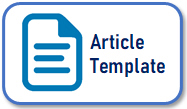Upaya Penggunaan Metode Telemetri untuk Penelitian Berang-Berang Cakar Kecil (Aonyx cinereus) di Area Persawahan
Abstract
Currently, telemetry appeared as a common method to reveal home range and movement of animal. However, the telemetry method was not applied for small-clawed otter yet. We have spent efforts to use the telemetry methods from March to August 2016 in a rice field landscape in Lubuk Alung district, Padang Pariaman regency, West Sumatra. We trapped individuals of small-clawed otters (Aonyx cinereus) using leg-hold traps and box traps. We implanted radio transmitter intraperitoneally. Movement of the animal was recorded using triangulation methods. Two male individuals of small-clawed otters were captured. One individual died soon after the transmitter implantation and another individual was successfully implanted and released. However the individual were detected for 28 hours only. In this paper, we described the efforts and problems appeared from the trapping, transmitter implantation, releasing and radio tracking process.
Keywords
Full Text:
PDFReferences
Aadrean. 2011. Ekologi Makan Berang-berang Cakar Kecil (Aonyx cinereus) di Area Persawahan Kabupaten Padang Pariaman. Tesis. Universitas Andalas. Padang.
American Veterinary Medical Association. 2008. Literature Review on the Welfare Implications of Legh old Trap Use in Conservation and Research. American Veterinary Medical Association Animal Welfare Division
Arnemo, J.M. 1991. Surgical Implantation of Intraperitoneal Radiotelemetry Devices in European River Otters (Lutra lutra). Proceeding of the V. International Otter Colloquium. Habitat 6, Hankensbuttel: 119
Asmoro, P.D. Melisch, & R. Kusumawardhanio.1994. Hubungan antara Berang-Berang dengan Manusia. Simposium Pertama Mengenai Berang-Berang di Indonesia. Bogor. 7 April 1994.
Belfiore, M. Natalia. 2008. Trapping and Handling of North American River Otters (Lontra Canadensis) in a Managed Marsh. Journal of Zoo and Wildlife Medicine, Vol. 39, No. 1 (maret 2008), pp. 13-20
Blundell, M. Gail, W. John, R. Terry, and K. Lawrence. 1999. Capturing River Otters: A Comparison of Hancock and Leg-Hold Traps. Wildlife Society Bulletin, Vol. 27, No. 1 (Spring, 1999), pp. 184-192
Fernández-Morán, Jesus, Saavedra, Deli., Manteca-Vilanova, Xavier. 2002. Reintroduction of the eurasian otter (Lutra lutra) in northeastern spain: trapping, handling, and medical management. Journal of Zoo and Wildlife Medicine, 33(3):222-227
Foster-Turley, P. A. 1992. Conservation Aspects of the Ecology of Asian Small-Clawed and Smooth Otters on the Malay Peninsula. IUCN Otter Spec. Group Bull. 7: 26-29
Haney, J.C. 2007. Translocations, transmitter effects, and veterinary care of otters (Mustelidae) during reintroduction: An Annotated Bibliography. Conservation Science and Economics Department Defenders of Wildlife
Iossa G, C.D Soulsbury, & S. Harris. 2007. Mammal trapping: a review of animal welfare standards of killing and restraining traps. Animal Welfare;16:335-352
Larivière, S. 2003. Amblonyx cinereus. Mammalian Species, American Society of Mammalogists, 720, 1–5.
Mech. L.David., Barber, Shannon M. 2002. A critique of wildlife radio-tracking and its use in national parks. A report to the u.s. national park service
Melissen, A. 2000. Eurasian Otter Lutra lutra Husbandry Otter. Otterpark AQUALUTRA.
Ó Néill, L, A. de Jongh, J Ozoliņš, T. de Jong, & J. Rochford. 2007. Minimising leghold trapping trauma for otters with mobile phone technology. J Wildl Manage 7:2776–2780
Ó Néill, L., P. Wilson, A. de Jongh, T. de Jong, and J. Rochford. (2008). Field techniques for handling, anaesthetising and fitting radio-transmitters to Eurasian otters (Lutra lutra). Eur J Wildl Res. 54:681–687.
Ruiz-Olmo, J., Jimenez, J. & Marco, I. 1991. Radiotracking a Translocated Otter in Spain. IUCN Otter Spec. Group Bull. 6: 6-7.
Serfass, T. L, R. P. Brooks, T. J. Swimley, L. M. Rymon, & A. H. Hayden. 1996. Considerations for cap turing, handling and translocating river otters. Wildl. Soc. Bull. 24: 25-31
Soto-Azat, C, F. Bober, G. Flores, E. Mora, A. Santibanez, & G. Medina-Vogel. 2006. Reversible Anesthesia In Wild Marine Otters (Lontra Felina) Using Ketamine And Medetomidine. Journal Of Zoo And Wildlife Medicine 37: 535–538.
Soto-Azat, C, F. Boher, G. Flores, R. Monsalve, A. Santibáñe., J. Vianna, & G. Medinavogel. 2011. Veterinary Management of Marine Otters (Lontra Felina) In Ecological Studies In Chile. IUCN Otter Spec. Group Bull. 28 (A).
Quaglietta, L., V. C. Fonseca , A. Mira , L. Boitani. 2014. Sociospatial organization of a solitary carnivore, the Eurasian otter (Lutra lutra). Journal of Mammalogy. 95(1):140–150
Walker, E.P. 1975. Mammals of the World. Third edition. Baltimore, Johns Hopkins Press. 2015 pp.White, G.C., and R.A. Garrott. 1990. Analysis of Wildlife Radio-tracking Data. Academic Press, San Diego, California.
Refbacks
- There are currently no refbacks.




